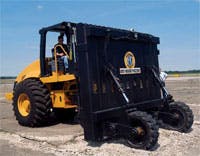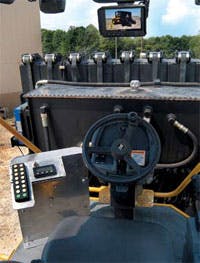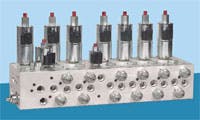Most concrete breakers in operation today are attachments that connect to the boom arms and hydraulic systems of excavators and other construction and demolition equipment. Some breaker attachments use chiseling tools that are designed to chip away at concrete. Others crush concrete with opposing drums. Until now, they typically derived their power from the host machine’s hydraulic system. That’s why there’s nothing on the market today quite like the new category of concrete breaker developed by Wag-Way Tool Co. Inc., Vincennes, Ind.
Wag-Way’s new Multi-Hammer Processor concrete breaker is a complete machine, not an attachment. It is optimized for breaking up huge expanses of thick airport or highway concrete into small pieces, which can be processed into a solid base or removed completely for a new surface. “After observing the concrete breakers that were out there, we saw the need for a better machine for the highway, road, and airport-construction industries,” explains Craig Waggoner, president of Wag-Way.
What it’s made of
The Multi-Hammer system consists of a partial machine from Caterpillar OEM Solutions integrated with hydraulically activated 1200-lb hammers arranged in 10- and 12-ft wide arrays that break the concrete with heavy impacts. The ability to sequentially drop one hammer at a time, a series of hammers, or all hammers at once also helps make this machine unique in the industry.
In addition to a partial machine, Caterpillar OEM provided its A5:M2 Electronic Control Module, some sensors, a small display, and a set of application configuration software tools for design and service.
The hammers drop from four predetermined heights to the concrete surface. The computer-controlled hydraulics in the Multi-Hammer Processor can raise the hammers (breaker heads) to different heights when required, depending on the application and the thickness of the concrete. Basic operation of the concrete-breaking machine includes a wide variety of options for configuring the machine’s hammer heads. “The operator has a 16-button panel from which to make selections,” says Tony Casale, engineering application manager at HydraForce Inc., Lincolnshire, Ill. HydraForce provides most of the hydraulic components for the machine and conducted systems integration work.
Six buttons control hammer sequences to determine in which order they fall. For example, the machine operator could start breaking concrete with the hammer heads from the middle of the array and working outward or have them drop all at once. “Whether you are breaking up a strip of concrete 4-ft wide and 6-in. deep or a section 10-ft wide by 12-in. deep, you can select a sequence and drop height to fit the job,” says Waggoner.
Hydraulics meet the needs
“In order to meet cycle times that range between 3 and 6 sec, the hydraulic system can generate flow to 50 gpm at 1500 psi,” says Casale. “The maximum hydraulic pressure is 2800 psi.”
The pumps that came on the partial Compactor Machine from Caterpillar were not used. Wag-Way replaced the original pump with one having a larger flow capacity. Most valves and other components came from HydraForce, with a few from Fasse Valves, Kearney, Neb., a supplier of electrohydraulic components, assemblies, and engineering and design services.
The Wag-Way Multi Hammer Processor is equipped with electronic controls that were designed with operator interface, operator safety, and machine performance in mind, according to Casale. The entire electronic network of sensors and controllers use CANBus technology for seamless communication. The machine also has operatorselectable controls for number of drops per foot, the drop sequence, and the drop height. Its control system includes impact-resistant electronics and a camera system for viewing the concrete breaking operation as it happens.
A history of partnering
Ron Kahn, an engineer with Caterpillar OEM Solutions, worked with Wag-Way early in the design and development process of the machine, when Wag-Way Founder Bob Waggoner (Craig’s father) originally came up with the idea for the new concrete breaker.
“Wag-Way had been a Caterpillar OEM Solutions customer for years with other machines besides the concrete breaker,” says Kahn. “A few years ago, they asked about taking our existing CS-563E vibratory compactor and retro-engineering it into a concrete breaker. They knew how much horsepower they needed, so they knew the CS-563E would work for them.”
The electronic controls, display, and configuration software are Caterpillar products provided through HydraForce in this instance. HydraForce used a pre-production version of Caterpillar configuration software to create the machine’s proprietary control system software for Wag-Way.
System integration
HydraForce became involved with the Wag-Way application through Fasse Valve partly because Hydra- Force Inc. has a line of hydraulic cartridge valves that accommodate flow rates ranging from 0.4 to 300 lpm (0.1 to 80 gpm) that fit the application.
Casale met early on with Wag-Way and Fasse Valves, which has vast experience in electrohydraulic control systems for Caterpillar machines. “In the Wag-Way case, we looked at how a machine operator would be pressing each of the buttons and how the hammers might possibly raise and lower in different sequences,” explains Casale. “We also looked at safety issues, such as interlocks, because we don’t want someone to be able to inadvertently cause the system to shut down.”
After he determined wag-Way’s needs and developed the system requirements, Casale defined the programming requirements for the full systems integration of electronic and hydraulic systems. From there, he developed a system architecture overview to apply to the concrete breaker’s electrohydraulic system. This overview allowed HydraForce to begin working up a graphical simulation of the electrohydraulic system, which helped Wag-Way engineers determine what happened when different buttons got pushed in different combinations and sequences.
Wag-Way has been associated with Caterpillar for nearly 20 years. However, their relationship with Hydra- Force began with the development of the Multi-Hammer Processor. “This was our first project that required computer control for the hydraulics,” says Waggoner. Thus, the successful project established a relationship between HydraForce and Wag-way.
Correcting overshoot
In addition to systems integration, HydraForce also provided a proprietary proportional valve technology to replace the existing two-position, two-way poppet and cartridge valves that had been part of the Caterpillar partial machine. In this case, HydraForce’s SP12-20 valves now help modulate fluid flow and allow the Wag-Way hammer heads to overcome a phenomena described by Casale as “over travel.”
“Over travel occurs because the hydraulic system is designed to raise the hammers to a pre-determined height based on the concrete thickness,” says Casale. “But the momentum of the 1200-lb hammers as they rise has no opposing force, so we created a profile of the raise rate that is used by the proportional valve to fine-tune the raise rate.” Now, the raise rate is initially fast, but then slows down at the end of the cycle, instead of only fast, as was the case in the early iterations of the hydraulic control-system design. “The SP12-20 proportional valve allows us to modulate that over-travel and fine tune the cycle times,” adds Casale.
The SP12-20 is HydraForce’s pilot- operated, normally closed proportional flow control valve that has decreasing pressure with increasing current. It can be infinitely adjusted across a prescribed range using a variable electric input. Flow output is proportional to a dc input.
Casale says the SP12-20’s solenoid is fully encapsulated within a metal shell. This makes it especially appropriate for the application because no water can penetrate the solenoid coil to short-circuit the valve, which helps make it reliable, even under the difficult operating requirements found at construction and demolition sites.
Bruce Wiebusch is a freelance technical writer in North Olmsted, Ohio.
For more information, contact
Wag Way Tool Co. at (800) 992-4929; www.wagway.com,
HydraForce Inc. at (847) 793-2300; www.hydraforce.com,
Caterpillar OEM Solutions at (309) 636-1100; www.cat.com, and
Fasse Valves at (308) 233-3040; www.fasse.com.




